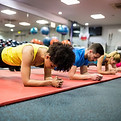SEDENTARY BEHAVIOR
Exercise/Stretches to Combat Sedentary Behavior
By Brenden A.
The average U.S.adult sits 6.5 hours a day and for teenagers, it’s even longer at 8 hours a day (Searing, 2019). Much of the blame could be placed on computer screens, as it’s a major tool for work and entertainment. According to the current Physical Activity Guidelines for Americans (Piercy, et al., 2018), the recommended amount of physical activity is 150 min of moderate intensity physical activity per week and 2 days of muscle strengthening activity.
You might be saying to yourself, “I ain’t got time for that”, but after you read this page I hope to show you how easily you can incorporate physical activity in your life. This page aims to offer some stretches/exercises that can be easy and convenient to do throughout the day. It’s important to note that the Exercises/stretches presented here are barely a fraction of the workouts that can help combat sedentary behavior. Simply attempting to move more throughout the day already provides more physical and psychological benefits than remaining sedentary. In addition, creating an active routine that YOU enjoy is also very important. Let this page be a rough draft of a workout routine you could create for your own life.
-
Walking/Running- Shocking! Yes, I know. This information isn’t anything groundbreaking. Regardless, walking/running is helpful in preventing the severe effects of sedentary behavior. A meta-analysis of nine cohort studies involving 44,000 volunteers of men and women were followed. This study concluded that higher sedentary time leads to higher mortality. However, the good news is that 30-40 minutes of Moderate to vigorous physical activity per day reduces this association between sedentary time and risk of death (Ekelund, et al., 2020).


-
Glute Bridges- This exercise is good for removing pressure on the lower back. It also strengthens the gluteal muscle group that is responsible for hip movement and ankle-hip alignment. Instructions:
-
Laying flat on a mat with arm to the sides, knees bent, and feet flat on the floor.
-
With your feet, push off the floor and lift your hips up until you're in a complete bridge position.
-
When you reach the top position, hold for one count while contracting your glutes.
-
After lowering your hips to the starting position, this completes one repetition.
-
Try doing 3 to 4 sets of 15 to 25 reps.
-
-
Plank- This exercise is important for protecting the back by strengthening the spine muscles, abdominal muscles, rhomboids and trapezius. This aids in maintaining posture, especially after long periods of sitting. Instructions:
-
Go into a push up position with elbows parallel to the ground.
-
When starting, place all weight on the forearms and forefoot of the feet and maintain a straight back.
-
Hold this position for as long as possible.
-
Try to do 3 sets of 60 seconds, if possible.
-


-
Forward Lunge and Rotation- This exercise is important for higher glute and core activation. It also promotes better proprioception and balance. Instructions:
-
Standing upright, lung forward keeping front knee at a 90 degree angle.
-
With the hand opposite to the leg that you stepped with, place it on the ground and rotate and reach with the other hand. Gaze should follow hand.
-
Finally, push off the front foot and move back into the starting position.
-
Try to do 5-10 rotations for each side.
-
-
Neck Stretches- It's important to take care of your neck muscles after prolonged sitting periods. When sitting, many individuals tend to lean their heads forward when working on computers. This places unnecessary load on the neck which could lead to increased upper back tension.
-
With one arm, hold on to the side of a chair.
-
With the opposite arm, tilt your head gently to the lateral side of that same arm.
-
Try to hold this stretch for 15-30 seconds, then move onto the other side.
-


-
Cross Arm Stretch- This stretch is focused on improving flexibility of the upper body and will be felt in the shoulders and upper back.
-
Sitting or standing tall, reach and extend one arm across the body
-
Hold extended arm with the opposite arm and gently pull back
-
Return to the starting position and repeat on the other side.
-
Try holding this stretch for 30 seconds per side.
-
Additional Information
Video presentations of the workouts mentioned above



References
Ekelund U, Tarp J, Fagerland MW, et al (2020). Joint associations of accelerometer-measured physical activity and sedentary time with all-cause mortality: a harmonised meta-analysis in more than 44 000 middle-aged and older individuals. British Journal of Sports Medicine ,54(24):1499-1506.
Piercy, K. L., Troiano R. P., Ballar, R. M., Carlson, S. A., Fulton, J. E., Galuska, D. A., George, S. M., Olson, R. D. (2018) The physical activity guidelines for americans. National Library of Medicine, 320(19), 2020-2028. doi: 10.1001/jama.2018.14854
Sering, L.(2019). The big number: The average U.S. adult sits 6.5 hours a day. For teens, it’s even more. The Washington Post. Retrieved November 30, 2022, from https://www.washingtonpost.com/national/health-science/the-big-numberthe-average-us- adult-sits-65-hours-a-day-for-teens-its-even-more/2019/04/26/7c29e4c2-676a-11e9-a1b6- b29b90efa879_story.html